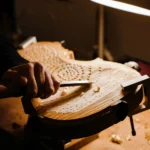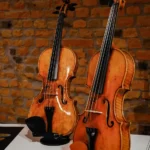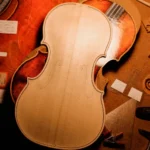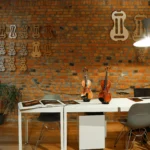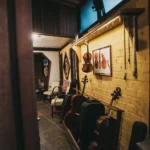History of German Bow Making
Back to BlogHistory Of German Bow Making
The violin, with its soothing melodies and mournful whispers, owes much of its expressiveness to the unassuming bow. While the French tradition of bow-making often steals the limelight, the story of German bow-making deserves a standing ovation. This lesser-known narrative reveals a vibrant history brimming with innovation, dedication, and a distinct approach to crafting these essential tools for musicians. Allow the blog to shed light on the history of German bow-making as we will discuss the prominent eras and people who defined the art.
Markneukirchen: The Cradle of German Bow Making (17th-18th Centuries)
The journey begins in the town of Markneukirchen, present amidst the Vogtland region of Saxony, Germany. This area, renowned for its long-standing woodworking and musical instrument-making traditions, laid the groundwork for the emergence of skilled bow-makers.
Josef Strötz (1715-1760)
Considered the innovator of Markneukirchen’s bow-making legacy, Strötz wasn’t solely a bow maker. Originally a Bavarian musician and carpenter, he brilliantly combined his skillsets. His handcrafted bows not only displayed his own talent but also drew business away from Schmalkalden, the previous German center for bow-making.
The Flourishing of German Bow-Making Workshops
Inspired by Strötz’s success, Markneukirchen witnessed a surge in bow-making workshops. Local records reveal a remarkable rise by the late 18th century. With over 18 active bow makers, these workshops churned out a substantial number of bows, exceeding 41,000 in a short period. This surge in production established Markneukirchen as a prominent center for bow-making in Germany. The 19th century marked a period of significant advancement and refinement within German bow-making.
Christian Wilhelm Knopf (1767-1837)
Often hailed as the “father” of the Markneukirchen bow-making school, Knopf played a pivotal role. He didn’t merely follow existing trends; he actively studied the advancements pioneered by European masters like John Dodd and François Xavier Tourte. By incorporating their techniques into his craft, Knopf established a distinctly German style. One of his significant contributions was the invention of the metal eyelet for the frog, a crucial component still used extensively today.
The German School
German bow makers like Christian Wilhelm Knopf and the Herrmann family made significant contributions during the 18th and 19th centuries. Notably, Knopf is credited with inventing the metal eyelet for the frog, a crucial component that improved durability and functionality.
One of the most significant contributions from Germany, however, came in the form of the “Cramer” bow. Developed during the transitional period between Baroque and Classical styles, the Cramer bow featured a stronger head, a longer stick, and a distinctive concave cambre. This design offered violinists greater control and facilitated a broader range of articulation compared to the Baroque bows. It is believed that the Cramer model was brought to Paris by violinist Wilhelm Cramer, who influenced French bow makers as well.
The Enduring Knopf Legacy
The passion for bow-making wasn’t confined to Christian Wilhelm Knopf. His descendants, including Carl Heinrich Knopf and J. Wilhelm Knopf, inherited the family tradition. They sharpened their skills, earning recognition as some of the most respected German bow makers of their time. Their work not only upheld the family’s legacy but also further propelled the reputation of German bow-making.
The 20th century brought about a diversification in the German bow-making landscape.
The Scars of War
The two World Wars significantly impacted the German bow-making industry, disrupting production and trade. Many workshops were damaged or destroyed, and skilled artisans were displaced. Despite these challenges, the tradition persevered. Skilled bowmakers continued their craft, adapting to the changing times and rebuilding the industry after the wars.
The “Transitional” Period
This period witnessed an interesting experiment. German bow makers began incorporating design elements from both Baroque and Tourte-style bows. Baroque bows were typically lighter and had a more convex stick, while Tourte bows were heavier and had a more concave stick. This fusion resulted in unique and highly sought-after bows known as “Transitional” bows. The “Cramer” model, developed in Germany during this era, exemplifies this innovative approach. These bows offered a blend of playability and power, appealing to a broader range of musicians.
Contemporary Masters
Today, German bow-making thrives on a foundation built over centuries. Contemporary German bow makers continue to produce high-quality bows, often specializing in specific types of bows like violin bows or cello bows. Catering to diverse price points, they cater to a wide range of musicians, from aspiring students to professional virtuosos. Many contemporary bow makers still utilize traditional techniques alongside modern advancements in tools and materials.
Beyond Mass Production
While German bowmaking is sometimes associated with mass-produced, student-grade instruments, this reputation overshadows the exceptional work of master bowmakers. Unfortunately, the sheer volume of lower-priced bows produced in Germany for a wider market contributed to the perception of a lesser quality.
In recent years, there has been a growing appreciation for the unique qualities of German bows. These bows are often praised for their affordability, responsiveness, and powerful sound. Additionally, the focus on ergonomics and playability makes them particularly popular with some violinists.
A Legacy of Innovation
The story of German bow-making is far from over. Contemporary German bow makers are building upon their heritage, experimenting with new materials and techniques while maintaining the tradition of meticulous craftsmanship.
German bow-making offers a rich and fascinating history. From the early workshops of Markneukirchen to the innovations of the Cramer bow, German artisans have left an undeniable mark on the world of string instruments. While overshadowed for a time by the French school, German bows offer a unique combination of affordability, playability, and power, ensuring their continued value for violinists and musicians of all levels.
So, violin enthusiasts, we hope that you found the blog on the History of German bow-making interesting enough. How about you visit Amorim Fine Violins and choose the violin bow that appeals to you the most? Sounds great right? We look forward to welcoming you.





